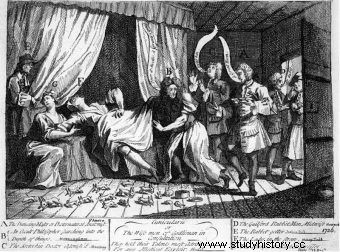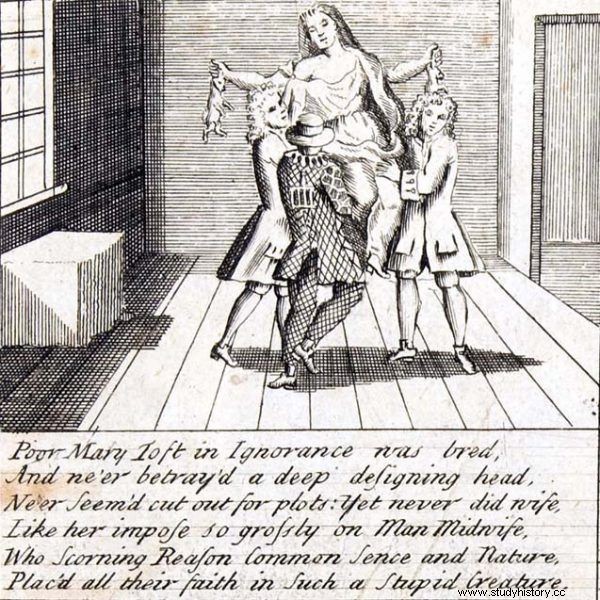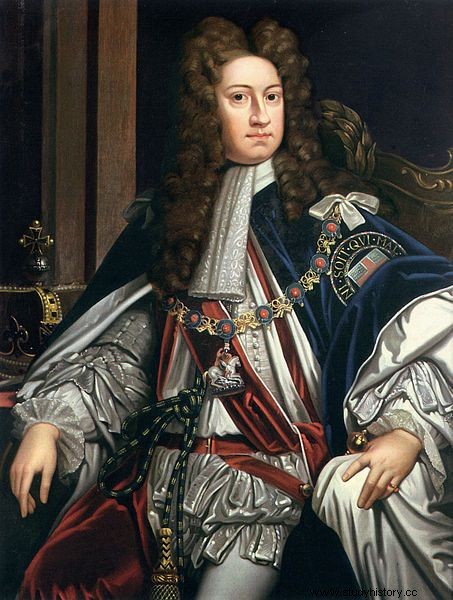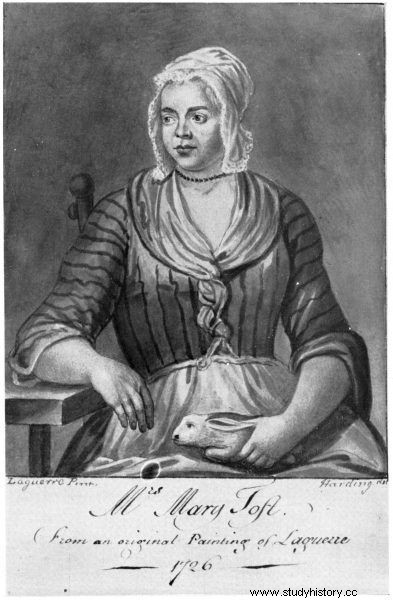England during the reign of King George I (1660-1727) was an extraordinary place. The king himself was not popular in society. He was not liked for his ignorance of English, and for putting German matters over English. He was also not popular because of keeping his wife in prison for 32 years. However, everything was beaten at that time by the story of a peasant woman named Mary Toft, who, while pregnant, began to give birth to ... rabbits.
Mary Toft, née Denyer, was from the poor village of Godalming in Surrey. At the age of 17, she married Joshua Toft, one year her senior, with whom she very quickly had two children. To support her family and have a roof over her head, Mary had to work hard in the fields. It was an obligation from which the eighteenth-century peasants were not exempted even by the fact of becoming pregnant. The women continued their work almost until the moment of delivery, often paying for it with miscarriages.

The story of Mary Toft was truly astonishing in England in the 18th century.
In August 1726, Mary, heavily pregnant with a third child, was working in a field when she and a friend spotted a rabbit. Without thinking, they decided to catch him and serve him to dinner. Unfortunately, the animal was faster. After a few days, however, it reappeared in the field to escape from the women again. This situation must have caused a lot of frustration in Mary, as the rabbit began to haunt her in her dreams as well. All this would soon result in a series of unexpected events that brought the name of Mary Toft into the pages of English history.
Rabbit's Annunciation
In the 18th century, it was believed that "a pregnant woman's strong emotions could have had a lasting effect on the unborn child." Anyway, a century later, with the same theory, many people explained the case of Joseph Merrick, known more widely as the Elephant Man . His mother, being pregnant, was about to get scared by an elephant, which resulted in the deformation of the baby's body in her belly. However, the story of the Toft family was much more macabre.

Did Mary Toft really give birth to rabbits?
Shortly after the appearance of the rabbit dreams, complications arose that made the young couple believe for a time that the woman had had a miscarriage. But that all changed on September 27, 1726, when Mary began giving birth unexpectedly. What she gave birth to was not, however, a human descendant.
The fetus was coming out of her body, but not as expected. The bits of the body were bare and skinned, but it was still easy to tell what the creature was. It was a rabbit.
Mother Rabbit
This extraordinary birth was accompanied by a local doctor, John Howard. Initially, the medic was skeptical about the whole situation, treating it rather as a one-off oddity. He was to change his opinion with the coming days, when the patient regularly started giving birth to more rabbit fetuses . Wanting to make sure that the woman was not deceiving him, he took her to his home for observation, where there were more births. In total, Mary gave birth to nine dead rabbits, and each birth was witnessed by the concerned and anxious Dr. Howard trying to alleviate her birth pain.
The doctor even noted how, by placing a hand on Mary's belly, he "felt the fetus move in there, as if it wanted to get out."
It is worth mentioning here that Mary's observations lasted so long that John, wishing to compensate the woman for her inability to work, paid her financial compensation.

King George I himself and his court medics became interested in the matter
Howard also wanted to share this extraordinary event and contacted England's most respected doctors and scientists. Thus, he caught the attention of Nathaniel St. André, Swiss anatomical surgeon practicing at the royal court of George I, and Samuel Molyneux, secretary to the Prince of Wales. The two men went to Guildford, where Howard practiced and observed the unusual patient.
In mid-November 1726, they arrived just in time to witness Mary's fifteenth birth. The others that followed only strengthened their belief that they were partakers of something extraordinary.
Other doctors soon joined the group of observers, including James Douglas, a Scottish anatomist, obstetrician and member of the Royal College of Physicians, and Cyriacus Ahlers, commissioned by King George I himself, and he was the cause of the fall of the entire rabbit masquerade.
Fraud emerges
Cyriacus Ahlers witnessed Mary's sixteenth birth, which immediately made him feel that all events were nothing but a hoax.
The doctor noted that, “Before giving birth, Mary went to bed with her knees tightly clenched. As if she was afraid the fetus might fall out. " He also performed an autopsy on a dead fetus and discovered “balls in the digestive tract. Balls of grain and hay. "
After drawing conclusions from his research, Ahlers went to London, where he told the king about everything. The monarch, wishing to end this farce, which was written about in all British newspapers, ordered the woman to be brought with the preserved fetuses to the capital.
The hoax is over. A London study found that rabbits could not have arisen in Mary's body, as some of them did not even look like fetuses and were about three months old.
It is also worth noting that with Toft's arrival in the capital, the births ended. At the same time, a porter from the guesthouse where the woman lived was caught smuggling rabbits into her room.
The boy later testified that Mary's sister-in-law, Margaret Toft, asked him to get the smallest rabbit he could find and deliver it to her brother's wife's room.
Sad truth
Although the births of the rabbits were not real, the pain was there. According to Mary's testimony, the trick was that an accomplice had put parts of dead animals into her vagina, which was a painful and dangerous task. Rabbits were often delivered with their sharp claws intact, and the remains of the animals were hidden in her body for a long time. The real miracle was that she didn't die of a bacterial infection.

Mary Toft was nicknamed the "trickster rabbit" after her death
To this day, historians are divided as to who actually stood behind the rabbit hoax. In her testimony, Toft has repeatedly blamed her husband and mother-in-law, but is considered by many to be a fanatic and money-hungry schemer. Let us remember, however, that it was a young woman whom life in extreme poverty had to experience a lot. And desperation can be one of the strongest incentives, regardless of its potential consequences.
Mary Toft was punished. On December 9, 1726, she was imprisoned in Bridewell Prison. Crowds of onlookers flocked in front of her public cell, which eventually led to her release and return to her home village. However, the bad reputation did not leave the woman until the day of her death. She died in 1763 at the age of 60. This event was recorded in parish records as the day that Mary Toft, the trickster rabbit, died.
